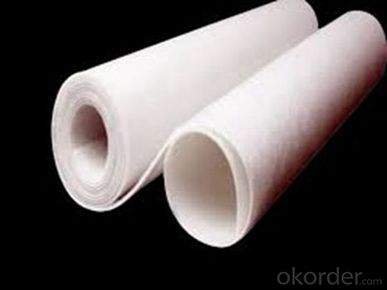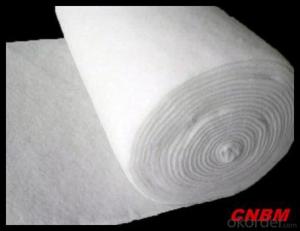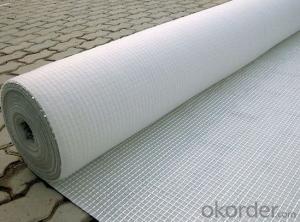Manta Geotextil Non-Woven Geotextile with Lightweight Compounding Silk-CNBM
- Loading Port:
- China main port
- Payment Terms:
- TT OR LC
- Min Order Qty:
- 6000 m²
- Supply Capability:
- 10000000 m²/month
OKorder Service Pledge
OKorder Financial Service
You Might Also Like
Specification
Detailed Images


Filtration:
It can be the filtration layer of the dykes, river canal, seacoast, concrete slope, retaining walls. At the same time of preventing the clay granule from passing, it allows the water and the gas pass through freely.
Reinforcement:
The highway, railway, soil-stone dam, breakwater, airport, backfill soil of retaining wall, slope protection, etc in which distributes the earth stress, prevents the side-displacement of the earth body and improves the earthbody stability.
Our Service
Quality assurance
1.On a regular basis or as per your request,we entrust national testing agencies to conduct quality inspections
2. Strictly in accordance with the ISO9001-2008 international quality system standard,we monitor and manage the whole process throughout production,quality testing,and measurement to ensure product quality
3. For quality-related construction delay or substandard construction(except for damage or losses due to customer’s responsibility or irresistible natural disasters),we have refunding,replacement,and repair services.We will respond to customers’ feedbacks on quality issues within 24 hours.
After-sales service
1.In order to provide customers with comprehensive technical support,we will provide technical and other related information upon request in a timely manner.
2.In required,we will appoint specialized technicians to the construction site to give technical trainings to construction people,and offer technical guidance throughout the whole construction process.
3.For damage due to shipment and delivery,after we receive the complaint,we will check the issure through provided pictures and videos.If our responsibility is confirmed,we wil offer free replacement.
4.When the construction is completed,as your request,our technical staff may participate in the final acceptance.
FAQ:
Q: What kind of payments does jenor support?
A: T/T, L/C, Cash are accepted.
Q: Do you charge for the samples?
A: Accordeing to our company policy, the samples are free, we only charge the freight fee. And we will return the freight fee during the next order.
Q: Can you produce according to customers' design?
A: Sure, we are professional manufacturer, OEM and ODM are both welcome.
Q: Do you have other products?
A: Yes, please check the pictures:
Packaging & Shipping
Packing: PLASTIC FILM INSIDE, AND WOVEN BAG OUTSIDE
Shipping: About 15 days after receipt the deposit
geotextile fabric
permeability,filtration,easy for construction
ISO and CE certificate
Good quality and competitive price
- Q: What is the difference between geotextile and impervious geotextile, geotextile and impervious geotextile?
- Geotextile play filter, filter, the role of reinforcement, with water permeability! Anti-seepage geotextile is generally made of geotextile and geomembrane compound, known as composite geomembrane, or simply as impervious geotextile, you can search for geotechnical materials Pan Huijie consultation to understand. Or user name consultation.
- Q: Geotechnical construction of the weather when there is any requirement
- Geotechnical construction of the weather when there is any requirement
- Q: Geomembrane bag bag is geomembrane or geotextile
- Geomembrane bags from the upper and lower layers is made of geotextile fabric, not geomembrane and geotextile, mainly used in the investigation of gong Guangqie chie off the locust Guiwei with slope, go to do the river on the use of (Hehe environmental geomembrane bag )good results
- Q: Subgrade geotextile lap law need to suture it
- General geotextiles require stitching. Geotextile stitching must be carried out continuously. Before the overlap, the geotextile must overlap at least 150mm. The minimum seam distance from the geotextile edge is not less than 25mm.
- Q: Roof garden pool at the bottom with pebbles, pebbles above with geotextile, geotextile above the soil
- Should be installed drainage board it! Geotechnical material manufacturers to answer!
- Q: What are the different geotextile installation techniques in filtration?
- Some of the different geotextile installation techniques in filtration include direct placement, trench installation, and wrapping. Direct placement involves placing the geotextile directly on the soil surface, while trench installation involves burying the geotextile in a trench or cut. Wrapping technique involves wrapping the geotextile around a structure or pipe to provide filtration. These techniques are used to enhance filtration and prevent soil erosion in various construction and environmental projects.
- Q: Can the geotextile function be a filter?
- The role of geotextile can do water filtration.
- Q: Can geotextiles be used in the protection of culverts?
- Yes, geotextiles can be used in the protection of culverts. Geotextiles are permeable fabrics that can be placed around culverts to prevent soil erosion and filter out sediments. They provide additional support and stability to the culvert, protecting it from damage and prolonging its lifespan.
- Q: Filament spunbond nonwoven geotextile performance requirements for what is the basic item
- Filament spunbond acupuncture non-woven geotextile is the implementation of the national standard GB / T-2008 standard. GB / T-2008 standard for filament spunbond acupuncture non-woven geotextile performance requirements of the basic items include: product vertical and horizontal nominal fracture strength (KN / m), vertical and horizontal nominal elongation at break (%) (KN), vertical and horizontal tearing strength (KN), mass per unit area deviation (%), width deviation (%), thickness (mm), vertical permeability coefficient (cm / s), equivalent pore size (O90 (95) / mm). Only the above indicators meet the corresponding GB / T-2008 standard requirements, be considered qualified filament spunbonded non-woven geotextile.
- Q: How do geotextiles help with reinforcement of geogrid reinforced soil slopes?
- Geotextiles help with the reinforcement of geogrid reinforced soil slopes by providing additional strength and stability to the system. They act as a separator between the soil and the geogrid, preventing soil particles from infiltrating the geogrid and reducing its effectiveness. The geotextiles also distribute the load evenly across the geogrid, improving its load-bearing capacity and reducing the potential for localized failures. Additionally, geotextiles can enhance the overall drainage and filtration properties of the slope, minimizing the risk of water accumulation and soil erosion.
Send your message to us
Manta Geotextil Non-Woven Geotextile with Lightweight Compounding Silk-CNBM
- Loading Port:
- China main port
- Payment Terms:
- TT OR LC
- Min Order Qty:
- 6000 m²
- Supply Capability:
- 10000000 m²/month
OKorder Service Pledge
OKorder Financial Service
Similar products
Hot products
Hot Searches
Related keywords




























